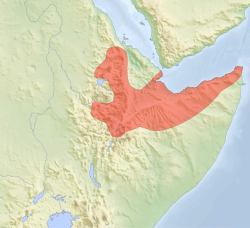
Back አዳል AM سلطنة عدل Arabic Sultanatu d'Adel AST Adalski sultanat BS Adal Catalan Adalský sultanát Czech Sultanatet Adel Danish Sultanat Adal German Sultanato de Adel Spanish Adal Sultanerria EU
This article contains too many quotations. (April 2024) |
Sultanate of Adal سلطنة عدل (Arabic) | |||||||||
|---|---|---|---|---|---|---|---|---|---|
| 1415–1577 | |||||||||
|
The combined three banners used by Ahmad al-Ghazi's forces | |||||||||
 The Adal Sultanate in c. 1540 | |||||||||
| Capital | |||||||||
| Official languages | Arabic | ||||||||
| Common languages | |||||||||
| Religion | |||||||||
| Government | Kingdom | ||||||||
| Sultan | |||||||||
• 1415–1423 (first) | Sabr ad-Din III | ||||||||
• 1577 (last) | Muhammad Gasa | ||||||||
| Historical era | Middle Ages | ||||||||
• Established | 1415 | ||||||||
• Sabr ad-Din III returns from exile in Yemen | 1415 | ||||||||
• War with Yeshaq I | 1415–1429 | ||||||||
• Succession Crisis | 1518–1526 | ||||||||
| 1529–1543 | |||||||||
• Disestablished | 1577 | ||||||||
| Currency | Ashrafi[2] | ||||||||
| |||||||||
| Today part of | |||||||||
The Adal Sultanate, also known as the Adal Empire or Bar Saʿad dīn (alt. spelling Adel Sultanate, Adal Sultanate) (Arabic: سلطنة عدل), was a medieval Sunni Muslim Empire which was located in the Horn of Africa.[3] It was founded by Sabr ad-Din III on the Harar plateau in Adal after the fall of the Sultanate of Ifat.[4] The kingdom flourished c. 1415 to 1577.[5] At its height, the polity under Sultan Badlay controlled the territory stretching from Cape Guardafui in Somalia to the port city of Suakin in Sudan.[6][7][8][9][10][11] The Adal Empire maintained a robust commercial and political relationship with the Ottoman Empire.[12] Sultanate of Adal was alternatively known as the federation of Zeila.[13]
- ^ Telles, Balthazar (1710). The Travels of the Jesuits in Ethiopia (1st ed.). J. Knapton.
It might perhaps be to called from Abaxa, the Capital City of the Kingdom of Adel.
- ^ Zekaria, Ahmed (1991). "Harari Coins: A Preliminary Survey". Journal of Ethiopian Studies. 24: 24. ISSN 0304-2243. JSTOR 41965992. Archived from the original on 2022-12-31. Retrieved 2024-01-15.
- ^ Ta'a, Tesema (2002). ""Bribing the Land": An Appraisal of the Farming Systems of the Maccaa Oromo in Wallagga". Northeast African Studies. 9 (3). Michigan State University Press: 99. doi:10.1353/nas.2007.0016. JSTOR 41931282. S2CID 201750719. Archived from the original on 2021-05-20. Retrieved 2021-09-07.
- ^ Ahmed, Hussein (2007). "Reflections on Historical and Contemporary Islam in Ethiopia and Somalia: A Comparative and Contrastive Overview". Journal of Ethiopian Studies. 40 (1/2). Institute of Ethiopian Studies: 264. JSTOR 41988230. Archived from the original on 2023-02-01. Retrieved 2023-03-22.
- ^ Elrich 2001, p. 36.
- ^ Pradines, Stéphane (7 November 2022). Historic Mosques in Sub-Saharan Africa From Timbuktu to Zanzibar. BRILL. p. 127. ISBN 9789004472617. Archived from the original on 22 May 2024. Retrieved 7 July 2023.
- ^ Braukamper, Ulrich (2002). Islamic History and Culture in Southern Ethiopia. Lit. p. 33. ISBN 9783825856717. Archived from the original on 2024-05-22. Retrieved 2023-07-07.
- ^ Owens, Travis. BELEAGUERED MUSLIM FORTRESSES AND ETHIOPIAN IMPERIAL EXPANSION FROM THE 13TH TO THE 16TH CENTURY (PDF). NAVAL POSTGRADUATE SCHOOL. p. 23. Archived (PDF) from the original on November 12, 2020.
- ^ Pouwels, Randall (31 March 2000). The History of Islam in Africa. Ohio University Press. p. 229. ISBN 9780821444610. Archived from the original on 18 September 2023. Retrieved 15 October 2020.
- ^ Leo, Africanus; Pory, John; Brown, Robert (1896). The history and description of Africa. Harvard University. London, Printed for the Hakluyt society. pp. 51–53.
- ^ Hassan, Mohamed. The Oromo of Ethiopia: A History, 1570-1860. p. 35.
- ^ Salvadore, Matteo (2016). The African Prester John and the Birth of Ethiopian-European Relations, 1402–1555. Routledge. p. 158. ISBN 978-1317045465. Retrieved 18 March 2018.
- ^ Brill, E. J. (1993). E.J. Brill's First Encyclopaedia of Islam 1913-1936. A - Bābā Beg · Volume 1. Brill. p. 126. ISBN 9789004097872. Archived from the original on 2024-05-22. Retrieved 2023-07-07.
